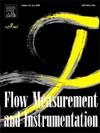Structural design and optimization of a high-precision laminar flow meter
IF 2.3
3区 工程技术
Q2 ENGINEERING, MECHANICAL
引用次数: 0
Abstract
Laminar flow meter is widely used in the field of gas micro-flow measurement, but it has the problems of poor linearity and excessive volume in micro-flow measurement. In this study, a sheet-type laminar flow meter based on the parallel pressure differential is proposed and the measurement principle, structural design and parameter calculation of the laminar flow meter are introduced. Tests were carried out on a prototype with a design flow range of 0–10 L/min. The standard device used in the tests was a FLUKE gas mass flow standard device with an extended uncertainty of 0.125 % (k = 2). The test results show that the maximum reading error of the prototype is 0.49 % without using any correction factor. The prototype achieves the design index of 0.8 level of accuracy, with a range ratio of 10:1. In addition, the linearity of the prototype is excellent, with a Remax d/L value of 17.42, which is larger than the conventional requirement of 2∼2.5. This indicates that this design can effectively overcome the nonlinearity caused by the entrance/exit effects and reduce the volume of the flowmeter.
高精度层流流量计的结构设计与优化
层流流量计广泛应用于气体微流量测量领域,但在微流量测量中存在线性度差、体积过大等问题。本文提出了一种基于并联压差的片状层流流量计,介绍了层流流量计的测量原理、结构设计和参数计算。在设计流量范围为0-10 L/min的样机上进行了试验。试验中使用的标准装置为FLUKE气体质量流量标准装置,扩展不确定度为0.125% (k = 2)。试验结果表明,在不使用任何校正因子的情况下,样机的最大读数误差为0.49%。样机达到0.8级精度的设计指标,量程比为10:1。此外,原型的线性度非常好,Remax d/L值为17.42,大于传统要求的2 ~ 2.5。这表明该设计可以有效地克服由进出口效应引起的非线性,减小流量计的体积。
本文章由计算机程序翻译,如有差异,请以英文原文为准。
求助全文
约1分钟内获得全文
求助全文
来源期刊

Flow Measurement and Instrumentation
工程技术-工程:机械
CiteScore
4.30
自引率
13.60%
发文量
123
审稿时长
6 months
期刊介绍:
Flow Measurement and Instrumentation is dedicated to disseminating the latest research results on all aspects of flow measurement, in both closed conduits and open channels. The design of flow measurement systems involves a wide variety of multidisciplinary activities including modelling the flow sensor, the fluid flow and the sensor/fluid interactions through the use of computation techniques; the development of advanced transducer systems and their associated signal processing and the laboratory and field assessment of the overall system under ideal and disturbed conditions.
FMI is the essential forum for critical information exchange, and contributions are particularly encouraged in the following areas of interest:
Modelling: the application of mathematical and computational modelling to the interaction of fluid dynamics with flowmeters, including flowmeter behaviour, improved flowmeter design and installation problems. Application of CAD/CAE techniques to flowmeter modelling are eligible.
Design and development: the detailed design of the flowmeter head and/or signal processing aspects of novel flowmeters. Emphasis is given to papers identifying new sensor configurations, multisensor flow measurement systems, non-intrusive flow metering techniques and the application of microelectronic techniques in smart or intelligent systems.
Calibration techniques: including descriptions of new or existing calibration facilities and techniques, calibration data from different flowmeter types, and calibration intercomparison data from different laboratories.
Installation effect data: dealing with the effects of non-ideal flow conditions on flowmeters. Papers combining a theoretical understanding of flowmeter behaviour with experimental work are particularly welcome.
 求助内容:
求助内容: 应助结果提醒方式:
应助结果提醒方式:


